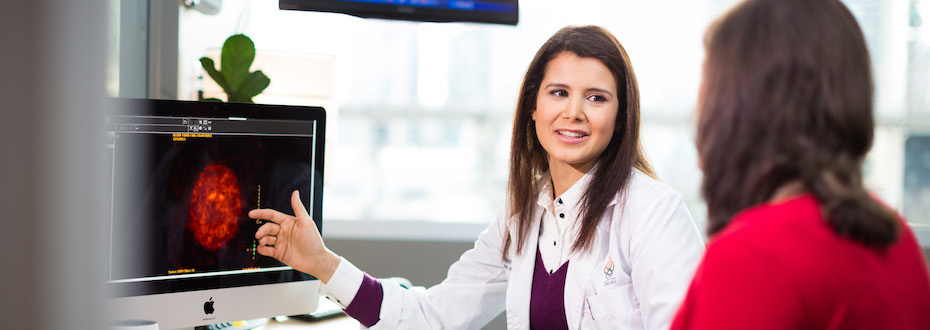For Providers: Is Your Parkinson’s or Essential Tremor Patient a Candidate for DBS?

Our team is your partner in caring for patients who might benefit from DBS surgery. We work with you and your patients to provide the best care for their condition.
- We carefully assess each patient's health and medical history to determine whether DBS might help them.
- We talk in detail with each patient about the procedure, including potential benefits and risks.
- We take brain scans to ensure the best possible placement of DBS electrodes.
- We work with you and your patient at follow-up appointments to fine-tune the DBS system for best results.
Is your Parkinson’s patient a candidate for DBS?
Parkinson's patients may be candidates for deep brain stimulation when medicine no longer improves their motor symptoms.
Patients might be good candidates if:
- They have a clear diagnosis of idiopathic Parkinson's.
- They have intact cognitive function.
- Their motor symptoms improve with medication, such as Sinemet, though their medication may no longer control tremor.
Patients are not good candidates if:
- They are severely disabled, even with medication.
- They have a "Parkinson's plus" diagnosis.
- Their symptoms have not improved with medication.
Learn more about our complete DBS patient selection criteria for Parkinson's patients.
Is your essential tremor patient a candidate for DBS?
Patients with essential tremor may be candidates for DBS if medication does not improve their symptoms.
Patients might be good candidates if:
- They have a clear diagnosis of essential tremor, or familial tremor.
- Medications no longer control their essential tremor, or the amount they need causes severe side effects.
- Their tremor causes significant functional disability and interferes with daily life: eating, drinking, writing or working.
Patients are not good candidates if:
- They have tremors because of ischemic disease or demyelination, which probably won't respond to DBS.
- They have other health conditions, such as serious cardiac disease or uncontrolled high blood pressure.
- They are pregnant.
Learn more about our complete DBS patient selection criteria for essential tremor patients.
You or your patients can also try Medtronic's eligibility tool.
Clinical pathway
We carefully evaluate Parkinson's disease and essential tremor patients to assess whether DBS is the right next step. We also assess risks of the procedure for each patient.
For patients who are good candidates and who decide to have the procedure, the main steps in their clinical pathway are below.
You can also view the steps as an infographic:
Your Parkinson’s disease patient will meet with several members of our DBS team:
- A neurologist who specializes in movement disorders
- A neurosurgeon
- A physical therapist to assess their movements over two days: when they are taking medication, and when they are not
- A speech therapist to assess speaking and swallowing
- A neuropsychologist to evaluate memory and thinking
- A social worker
Your essential tremor patient will meet with several members of our DBS team:
- A neurologist who specializes in movement disorders
- A neurosurgeon
- A physical therapist to assess their movements
- A speech therapist to assess speaking and swallowing
- A neuropsychologist to evaluate memory and thinking
- A social worker
These appointments may be available through telemedicine, via secure video link, when appropriate or more convenient for the patient.
Your patient will have another set of appointments with our team to prepare for DBS surgery:
- Internal medicine appointment: A provider in our Preoperative Medicine Clinic will make sure your patient is healthy enough for surgery and anesthesia.
- MRI appointment: Your patient will have a precise brain scan so their neurosurgeon can plan where to place the electrodes during surgery.
- Neurosurgery appointment: Your patient will meet the neurosurgeon to discuss surgery details and ask questions.
- Neuropsychology appointment (Parkinson’s only): Our team will test your patient’s cognitive function.
First surgery: We admit your patient to OHSU Hospital and put them under general anesthesia. Our DBS team takes a CT scan of the patient's brain, before surgery starts, to compare with the MRI images from before surgery. After surgery, patients typically spend one night in the hospital.
Second surgery: This surgery takes place up to a week after the first surgery. We put your patient under general anesthesia and place the small implanted pulse generator (IPG) under the skin, just below their collarbone. We connect thin wires from the electrodes placed in the first surgery to the IPG. Your patient will go home the same day.
Learn more about the DBS procedure.
Programming the IPG: About one month after the second surgery, our neurology team programs the IPG. We adjust the electrical impulses so they work best to treat symptoms.
Patients get a programmer that allows them to turn the generator on and off, and check its battery level. In some cases, patients can make minor adjustments to their settings.
Programming follow-up: Your patient will have monthly programming appointments until we have achieved the best symptom control. After that, they will see their local neurologist every six months for routine care and any needed IPG adjustments.
Your patient’s follow-up appointments may be at OHSU or with their local neurologist. Some patients may have follow-up appointments through telemedicine.
Refer a patient
- Refer your patient to OHSU.
- Call 503-494-4567 to seek provider-to-provider advice.
- Review our downloadable DBS guide for providers.